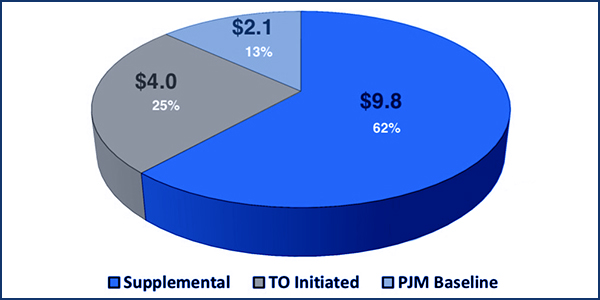By Christen Smith
Stakeholders representing load interests minced no words in a letter to PJM’s Board of Managers that criticized staff for rebuffing manual revisions they argue would increase transparency on transmission owners’ supplemental projects.
Signed by more than a dozen utility companies and state agencies — including American Municipal Power, Old Dominion Electric Cooperative, Kentucky’s Office of the Attorney General, the Delaware Department of Justice and the D.C. Office of the People’s Counsel, among others — the Feb. 8 letter accuses PJM of shirking its responsibility as an independent regional planner. It says the RTO failed to thoroughly vet the necessity of supplemental projects, which are managed by TOs and not deemed necessary for compliance under the RTO’s reliability, operational performance or economic criteria.
According to an AMP analysis, TO-requested projects totaled $7.2 billion in 2018, with nearly 80% classified as supplemental — a 219% increase over 2017. Meanwhile, PJM identified $560 million in baseline projects, which are those needed to solve future reliability and congestion issues.
“To be clear, the process as PJM staff is currently implementing it is not providing an adequate level of transparency,” the letter reads. “PJM is falling short of its requirements.”
Manual 14B Dispute
At last month’s Markets and Reliability Committee meeting, PJM rejected two paragraphs in a set of revisions that stakeholders approved for inclusion in Manual 14B: PJM Region Transmission Planning Process. (See PJM Rebuffs Stakeholders on Supplemental Projects.)
The paragraphs came from an AMP proposal — designed to address load interests’ concerns — that said supplemental projects “should be based on written articulable criteria, models and guidelines that are measurable and, to the extent available, quantifiable (e.g., asset replacement prioritization) so stakeholders can replicate TO planning decisions and validate their proposed solutions.” AMP cited the transparency principles in FERC Order 890, saying TOs should disclose asset-specific condition assessments and the criteria and models supporting supplemental projects.
Aaron Berner, PJM’s manager of transmission planning, called the disputed text an “overreach” of the RTO’s Regional Transmission Expansion Plan, which he said is limited to studies of load flows, short circuits and stability.
PJM Vice President of Planning Steve Herling later confirmed the RTO would not implement the proposed changes because they were “not consistent” with FERC rulings. “We don’t do this often, but we’re going to have to not implement what the members have approved,” he said immediately after the MRC approved the changes in a sector-weighted vote of 3.46 out of 5.
AMP’s proposal won unanimous support from the Electric Distributors and End-Use Customers sectors, 80% of Other Suppliers and 58% of Generation Owners. It was opposed by all but one member of the Transmission Owners sector.
‘Paradigm Shift’
In the letter, load interests insist PJM incorrectly interpreted federal guidance on regional transmission planning rules, describing its refusal to implement the AMP language as a “paradigm shift.”
“In light of the billions of dollars in supplemental projects proposed in recent years, it is untenable to hear that PJM believes that language such as ‘should’ and ‘to the extent possible’ is an ‘overreach’ by stakeholders,” the letter concludes. “It is equally untenable that PJM staff has no problem with disregarding the supermajority vote of the PJM stakeholders.”
PJM spokesman Jeff Shields said Wednesday the RTO remains committed to working with all stakeholders to maintain transparency and accountability. He cited its decision to clarify the term “useful life” in the manual as “not intended to indicate that facilities might be replaced solely based on them being fully depreciated.”
“The [other] manual changes forwarded to PJM are simply inconsistent with FERC’s description of PJM’s role in transmission planning,” Shields said. “PJM has exclusive purview over its manuals and is not required to introduce changes requested by stakeholders.”
In a separate letter to the board Feb. 11, the American Public Power Association (APPA) and the Transmission Access Policy Study Group (TAPS) said PJM’s refusal lacks “compelling justification.”
“The recently rejected Manual 14B revisions would have afforded stakeholders additional transparency concerning the basis, cost, timing and need for proposed supplemental projects,” wrote APPA CEO Susan Kelly and TAPS Executive Director John Twitty. “Transparency and opportunity for meaningful stakeholder participation in supplemental project planning help ensure that these projects will be cost-effective and beneficial to customers.”
The groups argued that PJM should not reject “broadly supported” manual changes designed to increase transparency around supplemental projects without “a compelling justification.”
“We urge the board to carefully consider the load group’s arguments that such a justification was lacking in the case of the rejected changes to Manual 14B,” the groups said.




